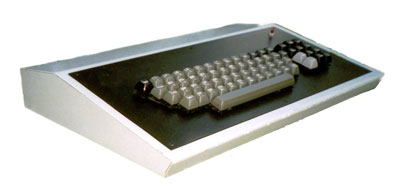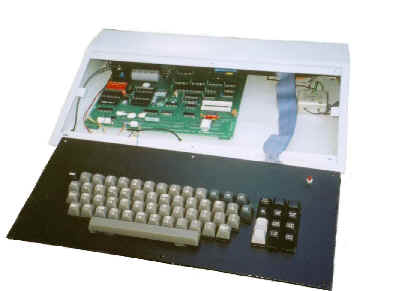
-
Designed using
embedded micro-controller with a unique algorithm
-
Generates both
perfect CW and the old time "bug" speed key sound
-
On-the-air in
its present form for over 40 years
Morse code keyboards
have been around for a long time now. I first remember reading
about one in the early 70's in QST. Those early designs were
hardware marvels with complex schematics. One of the commercial
offerings 1 cost $500! Later, of course, Morse code
keyboards used microprocessors. All were designed with the purpose
of eliminating human errors and variations. The Morse code keyboard
generated perfect CW, and sounded great. The dual paddle keyers
can also generate good CW. Soon everyone began to have the same
perfect sound. Today, there are still hand keys and bugs in
use, but they are in the minority. Perfect CW has become the
standard.
In 1980 I designed
a CW keyboard around the Z80 microprocessor for my own use.
I wire wrapped a prototype, added an ASCII keyboard made by
Cherry, placed it into a custom keyboard enclosure made for
the Cherry keyboard (I designed and had this enclosure made
for an earlier commercial project of mine), and then wrote the
assembly language code to make it run. Later on, I adapted a
Z80 printed circuit board (one I had designed for my employer)
to replace the wire wrapped prototype board. I now had an official
printed circuit board assembly, an excellent looking enclosure,
and a commercially made ASCII keyboard. I then got custom keyboard
key tops engraved for the special functions and Morse code symbols
needed. At this point, the hardware was finished. It was more
robust and looked better than anything commercially available.

Inside the Morse
Code Keyboard
Before this keyboard,
I used hand keys and then migrated to the dual paddle key and
iambimatic keyer 2. I never owned a semi-automatic
key like the Vibroplex. I have used them but never became proficient
in their use. In their day, bugs were an advantage because they
generated the dots (or Dits) automatically, saving the key operator
a lot of effort. The dashes (or Dahs) still required a manual
paddle depression and release for each one sent. The time length
of these Dahs depended upon the individual operating the speed
key. Many speed key operators can be identified by their own
individual keying characteristics (or fist). I knew it was Dan,
W8ZCQ (SK) before he even signed his call letters. It was just
like recognizing his voice. Of course, some operators sound
better than others, but I have noticed that bug users often
use the manually generated Dahs to their advantage. Sometimes
it's necessary to emphasize a particular letter in their call
sign that has been copied incorrectly by the DX station. Other
times emphasis can be added to attempt to compensate for bad
band conditions. Sometimes a change used at just the right spot
can generate humor or it may clarify a point of discussion.
You can't do this sending perfect CW.
I defined an algorithm
that modifies the perfect code sent by my keyboard. The change
depends upon where a Dah occurs. I added two momentary
key switch functions that define the degree of emphasis. This
way, I can select either "light" or "heavy"
implementation of the predefined change. Since these are momentary
action keys, I can instantly shift into the bug emulation mode.
A single character may be emphasized this way. For example,
the ending letter "K" sent after an exchange may be
lengthened from the normal Dah Dit Dah to a Daah Dit Dah, or
to a more emphasized Daaah Dit Dah. I don't usually use the
bug emulation all the time. I choose instead to selectively
emphasize where it's most effective. For fun, I sometimes call
CQ using the bug mode. Changing from normal code to the bug
emulation mode for a character or two has puzzled some listeners.
A DX station asked me if what I was doing was intentional, and
if so, how was I doing it? Usually the other stations don't
ask. They may figure I'm really skilled at using a bug, or that
I have two separate keys.
How does this sound
on the air? I can best describe it as sounding like a bug operator
with very uniform characteristics, although the choice of light
or heavy emphasis that I can instantly change distorts this
description. I'll consider adding an audio file here to let
you listen to it for yourself.
This Morse code
keyboard is still an essential station accessory. Despite its
age, it works well. The steel keyboard enclosure (great for
RFI suppression) and well made components have contributed to
its longevity. Somewhere during the process of converting from
the old CPM 8-inch floppy disk format to the smaller IBM PC
format in the early 1980's, I lost the original Z80 assembly
source code. However, I remember the bug emulation definition.
Since this Z80 hardware implementation is dated by today's standard,
I won't offer schematics of this controller. If I were to choose
to build one of these today, I would use a common stand-alone
PC keyboard hooked to a small custom PIC embedded controller
interface. This would be practical and still provide the same
result. Alternately, a program written on a PC with an interface
to one of the PC ports would work, but I prefer the stand-alone
keyboard approach.
I made this project
originally for utility and fun, and that's pretty much the definition
of CW.
Notes
1. "Curtis Electro Devices
KB-4200 Morse Keyboard", Recent Equipment Review, QST,
Oct. 1974, pg. 40-42.
2. Harry Gensler, Jr., K8OCO, "The
Iambimatic Concept", QST, Jan. 1967, pg. 18-21



